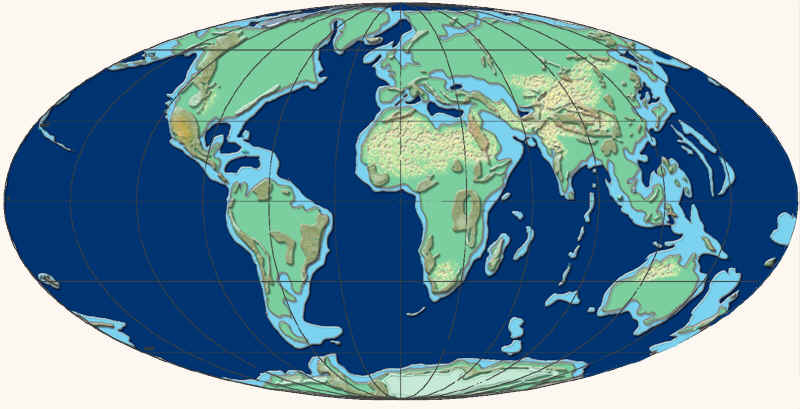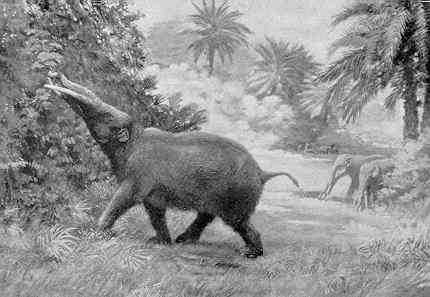
| Cenozoic | ||
| CENOZOIC | Neogene |
| Paleogene | Mesozoic | Cenozoic | ||
| Miocene | Timescale |
|
Cenozoic |
Geography Climate and adaptations Links |

The Neogene world (Middle Miocene)
after DinoData: Maps of Jan Golonka
The Neogene Period traditionally comprised the Miocene and Pliocene Epochs. Recent changes by the ICS appeared to eliminate the Quaternary, so that the Neogene included the Pleistocene and Holocene. Even more recently 2005-06), the ICS has indicated it will reanimate the Quaternary as a sort of stratigraphic Frankenstein assembled from ill-fitting spare parts, "gigantic in stature, yet uncouth and distorted in its proportions." However, in doing so, the ICS proposes to preserve the extension of the Neogene to the Present.
Not surprisingly, the Neogene globe looks much like our own. However, the relatively similar topology masks some dramatic changes. One of the best known is the Messinian salinity crisis at the Miocene- Pliocene boundary. In the Western Mediterranean, the Alboran Arc, a small subsea plate, drifted west, up against both Spain and North Africa. At the same time, deep magmatic upwelling slightly raised the profile of the entire region. As geologic events go, this was not front-page news. However, the collision sealed the western end of the Mediterranean for about 600,000 years. During this time, the Mediterranean Sea virtually dried up. On the other side of the African continent, three major rifts opened in roughly an east to west sequence: the Aqaba-Levant rift (today's Gulf of Aqaba), the Red Sea, and, late in Neogene time, the Afar Rift Valley where our own genus was born in the Late Pliocene.
These events were probably related to the counterclockwise rotation of the Arabian Plate and the continuing impact of India. During the Neogene, the Indian Plate was deflect from its northerly drift towards the north-west. Presumably the turn resulted from its impact with China and Asia. Crustal thickening under the Himalayas reached a maximum during the Pliocene, although the mountains continued to grow (as they are still growing today). The Neogene westerly component caused mountain building forces in Central Asia, raising the Caucasus and eventually draining most of the Caspian Ocean.
To some degree these events were mirrored in Europe, where Calabria (Italy) apparently underwent some complex combination of clockwise rotation and northeasterly translation, opening the Tyrrhenian Sea and stapling the Italian peninsula to the European mainland. At the same time, an important episode of mountain-building created the Alps to the north, and completed the Carpathians and Zagros mountains to the northeast.
 To the other side of India, Late in the Neogene, the Australian plate finally made contact with Asia, eventually raising the island of New Guinea. Jostling among other microplates accreting to the Asian mainland resulted in the formation of Taiwan, various Indonesian islands, the Kuril Islands, and the Philippines, as well as contributing to the growth and rotation of Japan.
To the other side of India, Late in the Neogene, the Australian plate finally made contact with Asia, eventually raising the island of New Guinea. Jostling among other microplates accreting to the Asian mainland resulted in the formation of Taiwan, various Indonesian islands, the Kuril Islands, and the Philippines, as well as contributing to the growth and rotation of Japan.
In North America, low sea levels, particularly in the Mid-Miocene, and the accumulation of a permanent North Polar ice cap allowed at least an intermittent bridge to remain between North America and Greenland. The North Polar ice cap was restricted to the shallow waters of arctic Canada and Greenland and probably did not yet reach the pole itself. Iceland emerged from a North Atlantic volcanic hot spot late during this interval. In western North America, north-south faulting, with east-west stretching and thinning of the crust occurred through a basin in Nevada, Arizona and Southern California. The resulting vulcanism is associated with the uplift of the Rocky Mountains on the east and the Sierra Nevadas on the west. The formation of the Sierras, in turn, was associated with the opening of the Gulf of California and major subsidence in the California Central Valley.
Both North and South America were drifting northward. However, South America was moving somewhat faster, and a permanent land bridge between the Americas developed late in the Neogene, probably by the Middle Pliocene. The closing of the Isthmus of Panama isolated the waters of the Gulf of Mexico and separated the marine biota of the east and west coasts.
Part of the reason that South America was moving more rapidly may have been that the Andes were passing over a crustal hot spot. In any event, South America experienced a prolonged period of mountain-building during the Neogene. The earlier stages of Andean mountain building had created a system of lagoons, and later lakes, in the South American interior, and a system of islands in the south. The further development of the mountains in the Neogene drained the lakes and linked most of the islands with the mainland. ATW030901, revised ATW060905.
 The Neogene Period spans 22 million years, during which the world became much drier and cooler, culminating in the biotic disaster of the Pleistocene ice ages and the harsh conditions of our own day. During this interval, the relatively uniform and stable climatic regime which had cradled the world's ecosystems for 200 million years, since the Late Triassic, came to a comparatively quick end. Conditions had been deteriorating since the end of the Mesozoic. The Paleogene included times of marked climatic instability that are poorly understood, and the waters near the poles had begun to cool. However, the Paleogene world was still -- by today's standards, at least -- thickly forested, warm, humid, and without strong regionalism or wide seasonal temperature swings.
The Neogene Period spans 22 million years, during which the world became much drier and cooler, culminating in the biotic disaster of the Pleistocene ice ages and the harsh conditions of our own day. During this interval, the relatively uniform and stable climatic regime which had cradled the world's ecosystems for 200 million years, since the Late Triassic, came to a comparatively quick end. Conditions had been deteriorating since the end of the Mesozoic. The Paleogene included times of marked climatic instability that are poorly understood, and the waters near the poles had begun to cool. However, the Paleogene world was still -- by today's standards, at least -- thickly forested, warm, humid, and without strong regionalism or wide seasonal temperature swings.
By the end of the Pliocene, this had all come to an end. The drift of the continents had sealed off the waters of the far arctic, as the northern margins of Asia and North America crowded together. In the south, Antarctica, now out of contact with any other landmass, was circled by a continuous circum-polar current. Thus both poles were thermally isolated from warm equatorial waters; and (perhaps for the first time since the Ordovician) both poles accumulated heavy coverings of ice. The ice sheets, in turn reflected more sunlight (increased albedo) and lowered sea levels, further reducing temperatures and warm-water circulation. At the same time, the virtual closing of east-west circulation through the Mediterranean Sea and between the Americas isolated those waters, allowing the build-up of hot, circulating currents, conducive to monsoon seasonality.
 The world dried out. Huge deserts developed in North Africa and Central Asia. The deep forests of the continental interiors of the Americas, Asia, Europe, and even Australia were replaced by arid plains, steppe, prairie and tundra. Grasses appeared at the beginning of the Miocene and quickly replaced the thinning forests. But grasses are poor fodder: tough, low in nutrients, high in tooth-destroying silicates. They die back to their roots in cold weather. Under the triple hammers of drought, starvation and cold, herbivorous species were smashed or utterly changed. Their predators followed them into extinction or transformation. The later Neogene saw the creation of an entirely new guild of hunters, the pursuit predator, able to follow scarce prey across miles of open country rather than waiting for the easier opportunity which might never come. The pursued developed their own responses: herd behaviors, seasonal migrations, and big bodies, adapted for speed and endurance.
The world dried out. Huge deserts developed in North Africa and Central Asia. The deep forests of the continental interiors of the Americas, Asia, Europe, and even Australia were replaced by arid plains, steppe, prairie and tundra. Grasses appeared at the beginning of the Miocene and quickly replaced the thinning forests. But grasses are poor fodder: tough, low in nutrients, high in tooth-destroying silicates. They die back to their roots in cold weather. Under the triple hammers of drought, starvation and cold, herbivorous species were smashed or utterly changed. Their predators followed them into extinction or transformation. The later Neogene saw the creation of an entirely new guild of hunters, the pursuit predator, able to follow scarce prey across miles of open country rather than waiting for the easier opportunity which might never come. The pursued developed their own responses: herd behaviors, seasonal migrations, and big bodies, adapted for speed and endurance.
Another line of adaptation led to small-bodied generalists -- rodents, raccoons, rabbits, and possums -- and their predators, the foxes, cats, dogs and snakes. These generalists were mainly unspecialized herbivores or omnivores, with partially fossorial habits, strong territoriality and high reproductive rates. Theirs was the ability to exploit many resources within small, locally or temporarily favorable conditions, excluding competition and using rapid reproduction as a defense to predation, to quickly take new territory, or to recover from local disasters. These organisms often developed seasonal torpor as a method for surviving seasonal extremes.
A few species do not fall neatly into any of these categories. Humans are one. Bears are another. In one sense, these are hyper-generalists, able to use a wide repertoire of behavioral adaptations to compensate for a conspicuous absence of genetically-endowed talents. In another sense, they are throw-backs to a style of life more common in the Paleogene or the Late Mesozoic. The survival of this group is hard to explain, with so many other, robust lineages disappearing. One wonders what fate an unbiased Pliocene biologist would have predicted for such strange creatures. ATW030901.
Neogene Marine Biota of Tropical America home page - an online biotic database containing images and data for taxa used in analyses of Tropical American biodiversity over the past 25 million years.
Tertiary Paleogeography: maps and commentary from Robert Blakey on the tectonics of the American Southwest. Also, don't miss Dr. Blakey's new (2003) Miocene paleoglobes.
Walking With Prehistoric Beasts - DVD also in VHS - by the team that brought you Walking With Dinosaurs